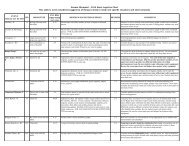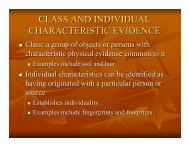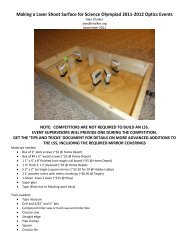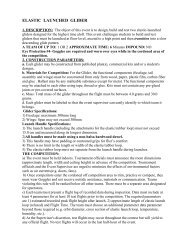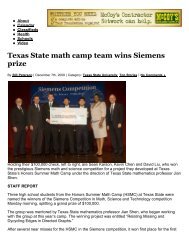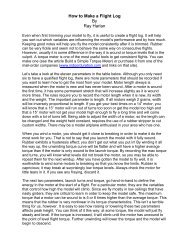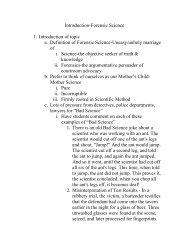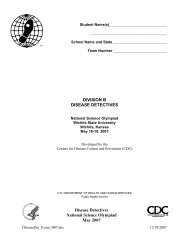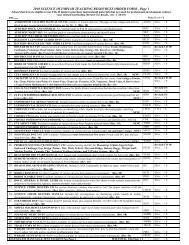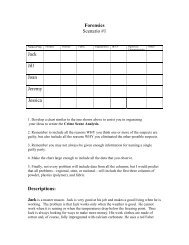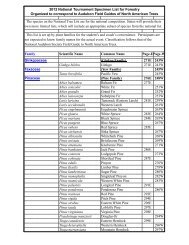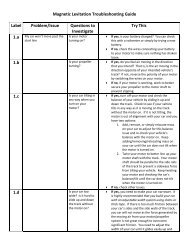Topo Features of Alpine Glaciers LAB
Topo Features of Alpine Glaciers LAB
Topo Features of Alpine Glaciers LAB
You also want an ePaper? Increase the reach of your titles
YUMPU automatically turns print PDFs into web optimized ePapers that Google loves.
Name: _______________________________<br />
Period: _____ Date: ____________________<br />
<strong>LAB</strong>: <strong>Topo</strong>graphic <strong>Features</strong> and Advance/Retreat <strong>of</strong> <strong>Alpine</strong> <strong>Glaciers</strong><br />
Background:<br />
The map in this lab shows<br />
three glaciers in the Juneau Ice<br />
Field in Alaska. It shows the<br />
Taku Glacier, one <strong>of</strong> the<br />
largest glaciers in the ice field<br />
as well as the smaller Norris,<br />
and Hole-in-the-Wall <strong>Glaciers</strong>.<br />
The topographic map includes<br />
land contours, glacial<br />
contours, and the positions <strong>of</strong><br />
the margin <strong>of</strong> each glacier at<br />
different times since 1890.<br />
<strong>Glaciers</strong> gain and lose snow<br />
and ice each year. The amount<br />
<strong>of</strong> snow and ice added to a<br />
glacier is called accumulation and amount lost due to melting is called ablation. This relationship is<br />
called the glacial budget.<br />
In this lab, you are going to analyze the topographic map to determine glacial features, such as U-shaped<br />
valleys, sharp mountain peaks, and moraines, as well as the dimensions <strong>of</strong> the glaciers. The map was<br />
made in 1980, and includes positions <strong>of</strong> the terminus (ice margin) during different times since 1890.<br />
Where are the glaciers now, in 2013? By determining the rate <strong>of</strong> advance or retreat, we can predict<br />
where the glacier will be in the future. Of course, this may depend on the rate not changing over time.<br />
Make a prediction as to where you think the glaciers are now, and then write a conclusion after you<br />
analyze your data and review Google map images <strong>of</strong> the Taku Glacier Region.<br />
Hypothesis: ____________________________________________________________<br />
PART 1: <strong>Topo</strong>graphic Map Analysis<br />
Directions: Answer the following questions based upon the map <strong>of</strong> <strong>Alpine</strong> <strong>Glaciers</strong> in the<br />
Juneau Icefield, Alaska.<br />
1. Lightly shade the areas <strong>of</strong> ice, land and water on the map.<br />
Lowland = brown Highland - Green Water = blue <strong>Glaciers</strong> = white<br />
Copyright: Gary R. Vorwald, Paul J. Gelinas jHS, Setuaket, NY 2013<br />
(May be used for educational purposes; please credit author)
2. What is the contour interval <strong>of</strong> the land on this map? _________________________<br />
3. a. What is the highest elevation on the map? ________________<br />
b. Where is this located? ________________________________________________<br />
4. What is the approximate elevation <strong>of</strong> the Taku River? _______________<br />
5. What is the contour interval <strong>of</strong> the glacier on this map? _______________________<br />
6. Using the scale, measure the north-south distance covered by the map in miles and kilometers.<br />
_________________ mi<br />
_________________km<br />
7. Measure the east-west distance covered by the map in miles and kilometers.<br />
_________________ mi<br />
________________ km<br />
8. What is the approximate latitude and longitude <strong>of</strong> the Taku Glacier along it’s 1980 front at point X?<br />
(Your answer should be stated to the nearest degree and minute)<br />
_____________________________________________________<br />
9. State the width <strong>of</strong> the Taku Glacier at the terminus (end). _____________________<br />
10. State the width <strong>of</strong> the Taku glacier at the 1000 ft. contour. _____________________<br />
11. Calculate the gradient <strong>of</strong> the Taku Glacier from point Y along the 1000ft contour to point Z (at the<br />
Taku River, elevation 0 ft.). (Rate should be expressed in feet per mile)<br />
a. State the<br />
Equation for<br />
Gradient<br />
b. Substitute Values<br />
into the Equation<br />
c. Solve the<br />
equation and state<br />
your Final Answer<br />
Gradient = _________________________<br />
Gradient = _________________________<br />
Gradient = _________________________<br />
Copyright: Gary R. Vorwald, Paul J. Gelinas jHS, Setuaket, NY 2013<br />
(May be used for educational purposes; please credit author)
Draw a topographic pr<strong>of</strong>ile across the Taku Glacier, from point A to point B. Plot each elevation value<br />
using a point and then connect the points with a smooth line. Draw a dashed line to show your<br />
interpretation <strong>of</strong> the depth <strong>of</strong> the glacier and Taku River.<br />
12. Based on your pr<strong>of</strong>ile, how thick is the Taku Glacier? ____________________<br />
13. What is the name <strong>of</strong> the glacial landform at A? _____________________<br />
14. Describe or give the name <strong>of</strong> the glacial landform directly east <strong>of</strong> the 1000 ft contour on<br />
the Taku Glacier? ________________________________________________________<br />
15. When the Taku Glacier completely melts, what shape will the valley be? ____________<br />
16. Describe the topography <strong>of</strong> this region. _____________________________________<br />
________________________________________________________________________<br />
17. The dark lines on the glacier indicate the position <strong>of</strong> the glaciers terminus (glaciers front) at<br />
various dates in the past. Use this information to state if the glaciers appear to be advancing or<br />
retreating.<br />
Taku Glacier = ________________________ Norris Glacier = ______________________<br />
Hole-in-the-Wall Glacier = __________________________<br />
Copyright: Gary R. Vorwald, Paul J. Gelinas jHS, Setuaket, NY 2013<br />
(May be used for educational purposes; please credit author)
PART 2: Prediction <strong>of</strong> Position <strong>of</strong> <strong>Glaciers</strong><br />
1. Calculate the rate <strong>of</strong> movement <strong>of</strong> the Taku Glacier for the following periods <strong>of</strong> time:<br />
1890-1929; 1929-1948; 1948 – 1980.<br />
Use the kilometer scale. Calculate rate in both km/yr and meters/year. 1 km = 1000 meters.<br />
a. 1890 – 1929<br />
Distance (km)<br />
Distance<br />
(meters) Time (years) Rate (km/yr) Rate (m/yr)<br />
b. 1929 – 1948<br />
Distance (km)<br />
Distance<br />
(meters) Time (years) Rate (km/yr) Rate (m/yr)<br />
c. 1948 – 1980<br />
Distance (km)<br />
Distance<br />
(meters) Time (years) Rate (km/yr) Rate (m/yr)<br />
2. Based on your calculations, describe your observations <strong>of</strong> the rate from 1890 – 1980.<br />
________________________________________________________________________<br />
________________________________________________________________________<br />
________________________________________________________________________<br />
Copyright: Gary R. Vorwald, Paul J. Gelinas jHS, Setuaket, NY 2013<br />
(May be used for educational purposes; please credit author)
3. Use your calculations <strong>of</strong> rate to predict where the Taku Glacier is now (2013). You decide which<br />
interval to use.<br />
Convert the rate formula to solve for the predicted distance.<br />
Rate = Distance/Time Distance =<br />
Rate (km/yr) Time (years) Predicted Distance<br />
(km)<br />
4. Indicate on the map where you think the Taku Glacier is today, based on your calculations.<br />
5. Predict the location <strong>of</strong> the Norris Glacier in 2010. Use a red marker or pencil.<br />
Distance (km)<br />
Distance<br />
(meters) Time (years) Rate (km/yr) Rate (m/yr)<br />
Rate (km/yr) Time (years) Predicted Distance<br />
(km)<br />
Indicate the location <strong>of</strong> the Norris Glacier on the map. Use a red marker or pencil.<br />
Copyright: Gary R. Vorwald, Paul J. Gelinas jHS, Setuaket, NY 2013<br />
(May be used for educational purposes; please credit author)
Discussion Questions:<br />
1. What is the length, width, and approximate thickness <strong>of</strong> an <strong>Alpine</strong> (Valley) Glacier?<br />
___________________________________________________________________<br />
___________________________________________________________________<br />
___________________________________________________________________<br />
2. What are some topographic characteristics <strong>of</strong> a region that has been affected by alpine glaciers?<br />
Describe some landforms observed on your map <strong>of</strong> the Taku Glacier. Include the shape <strong>of</strong> the<br />
valley being carved by the glaciers.<br />
___________________________________________________________________<br />
___________________________________________________________________<br />
___________________________________________________________________<br />
___________________________________________________________________<br />
3. What conditions cause a glacier to advance or retreat? (Relate to annual snowfall accumulation<br />
and melting/ablation)<br />
___________________________________________________________________<br />
___________________________________________________________________<br />
___________________________________________________________________<br />
___________________________________________________________________<br />
4. The Taku Glacier currently appears have been in a state <strong>of</strong> Dynamic Equilibrium since 1980 .<br />
Explain what the relationship between accumulation and melting is and describe where the<br />
glacier is now compared to the river.<br />
___________________________________________________________________<br />
___________________________________________________________________<br />
___________________________________________________________________<br />
Copyright: Gary R. Vorwald, Paul J. Gelinas jHS, Setuaket, NY 2013<br />
(May be used for educational purposes; please credit author)
___________________________________________________________________<br />
Conclusion: Write a conclusion about what you learned about glaciers from this lab. Include<br />
information about your rate calculations and how you can predict future positions <strong>of</strong> a glacier.<br />
___________________________________________________________________<br />
___________________________________________________________________<br />
___________________________________________________________________<br />
___________________________________________________________________<br />
___________________________________________________________________<br />
___________________________________________________________________<br />
___________________________________________________________________<br />
___________________________________________________________________<br />
Evaluation:<br />
___________________________________________________________________<br />
___________________________________________________________________<br />
___________________________________________________________________<br />
___________________________________________________________________<br />
___________________________________________________________________<br />
___________________________________________________________________<br />
___________________________________________________________________<br />
___________________________________________________________________<br />
Copyright: Gary R. Vorwald, Paul J. Gelinas jHS, Setuaket, NY 2013<br />
(May be used for educational purposes; please credit author)
Copyright: Gary R. Vorwald, Paul J. Gelinas jHS, Setuaket, NY 2013<br />
(May be used for educational purposes; please credit author)



